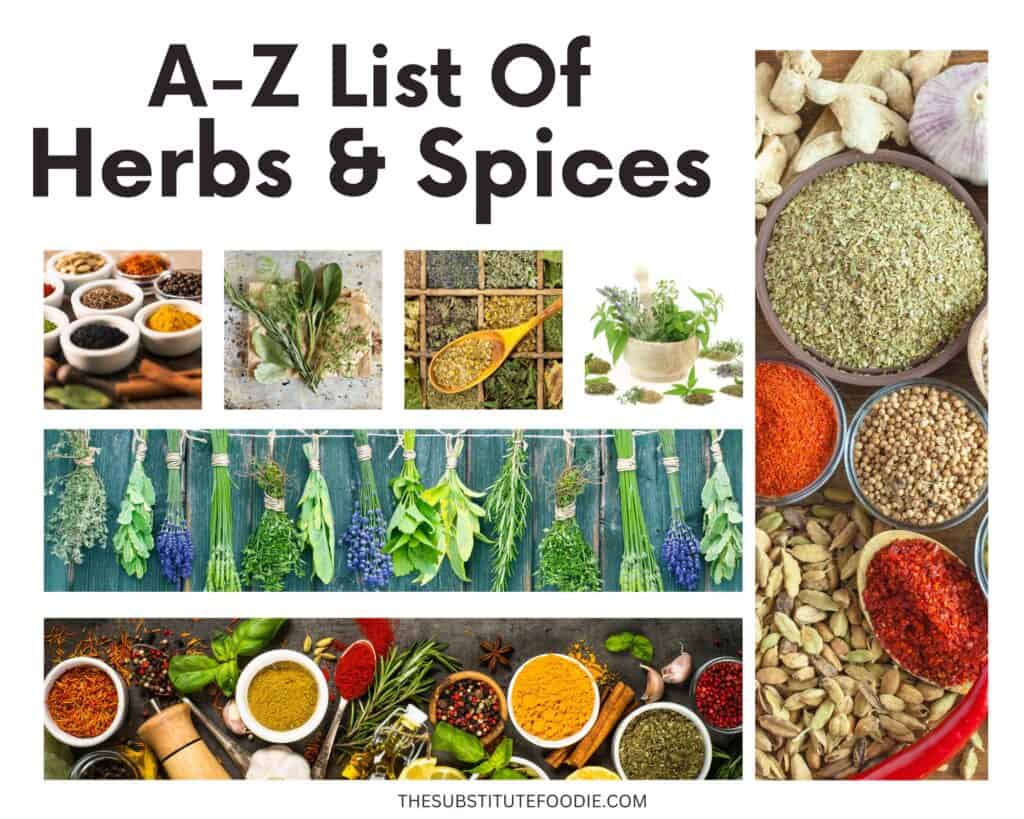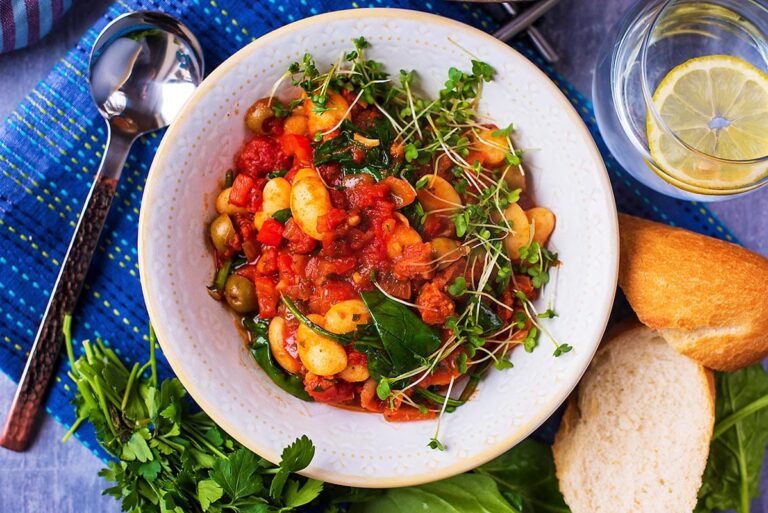A-Z List of Herbs and Spices
This post may contain affiliate links. Please see my disclosure policy for details.
As a home cook or a gardener, you know the importance of herbs and spices. These plants are not just for cooking, but they also have health benefits as well. That is why we want to share with you our A-Z list of culinary herbs and spices so that you can better understand what these plants do in your garden and kitchen and how to use them.
Alphabetical list of Herbs & Spices

Ajwain: Also known as carom seeds, ajwain is a common spice in Indian cuisine. It’s known for its health benefits and unique flavor. The seeds have a bitter and pungent flavor and are used in various medicines.
Allspice: Allspice is the dried fruit of the Pimenta dioica plant. It has a taste that’s reminiscent of a combination of nutmeg, cloves, and cinnamon.
Anise: Anise has a sweet, aromatic taste that resembles the flavor of black licorice. It’s often used in baking, cooking, and liquor production.
Annatto: Often used in Latin American and Caribbean cuisine, annatto seeds impart a slightly sweet, nutty flavor and a bright orange color.
Asafoetida (Hing): A potent spice used in Indian and Middle Eastern cuisines known for its strong, onion-like flavor.
Basil: Basil is a fragrant herb commonly used in Italian and Southeast Asian cuisines. It comes in many varieties, including sweet basil and Thai basil.
Basil (Holy): Also known as tulsi, holy basil is used in Ayurvedic medicine and is considered sacred in Hindu religious practices.
Bay Leaf: Bay leaves come from the bay laurel tree, and they impart a subtle bitterness that helps balance flavors in dishes.
Black Cumin: Black cumin, also known as Nigella seeds, have a slightly bitter, onion-like flavor and are often used in Middle Eastern and Indian cuisines.
Black Pepper: One of the most common spices worldwide, black pepper is mildly spicy and slightly aromatic.
Capers: Capers are flower buds that have been pickled. They’re tangy and salty and are often used in Mediterranean cuisine.
Caraway: Caraway seeds have a warm, slightly sweet flavor and are often used in breads, especially rye bread.
Cardamom: Cardamom is sweet and spicy, with a slightly minty flavor. It’s often used in Indian and Middle Eastern cuisines.
Cassia: Cassia is a type of cinnamon with a stronger, more bitter flavor than Ceylon cinnamon.
Cayenne Pepper: Cayenne pepper is a type of chili pepper that’s moderately hot. It’s often used in spice blends and on its own.
Celery Leaf: Celery leaves are often used in soups and salads for their strong celery flavor.
Celery Seed: Celery seeds have a strong, concentrated celery flavor and are often used in pickling brines and spice blends.
Chervil: Chervil has a mild flavor with hints of anise. It’s often used in French cuisine.
Chicory: Chicory has a slightly bitter flavor and is often used in salads or as a coffee substitute.
Chili Pepper: Chili peppers come in many varieties, each with its own level of heat. They’re used to add spice to dishes.
Chives: Chives have a mild onion flavor and are often used as a garnish.
Cilantro: Cilantro, also known as coriander leaves, has a bright, citrusy flavor. Some people find that it tastes soapy.
Cinnamon: Cinnamon is sweet and slightly spicy. It’s often used in baking and in savory dishes in Middle Eastern cuisine.
Clary Sage: Clary sage has a slightly sweet, floral flavor and is often used in teas.
Cloves: Cloves are sweet and very aromatic. They’re often used in baking and in Indian cuisine.
Coriander Seeds: Coriander seeds have a warm, citrusy flavor and are often used in Indian and Mexican cuisines.
Cumin: Cumin has a warm, earthy flavor and is a key ingredient in many spice blends.
Curry Leaf: Curry leaves are very aromatic and are a staple in Indian and Sri Lankan cuisines.
Dill: Dill has a bright, tangy flavor and is often used in Eastern European cuisine.
Elderflower: Elderflowers have a sweet, floral flavor and are often used to make syrups and liqueurs.
Epazote: A herb used in traditional Mexican dishes, including beans and moles
Fennel: Fennel has a sweet, licorice-like flavor. The seeds, fronds, and bulb are all edible.
Fenugreek: Fenugreek has a slightly sweet, nutty flavor and is often used in Indian cuisine.
Galangal: Galangal is similar to ginger but has a more citrusy, piney flavor. It’s often used in Thai and Indonesian cuisines.
Garam Masala: A blend of ground spices used extensively in Indian cuisine.
Garlic: Garlic is pungent and slightly spicy. It’s used in cuisines worldwide.
Ginger: Ginger is spicy and slightly sweet. It’s used in many different types of cuisines, from Chinese to Caribbean.
Grains of Paradise: A West African spice that has a pungent, peppery flavor.
Hibiscus: Hibiscus flowers have a tart flavor and are often used to make tea and natural food colorings.
Horseradish: Horseradish is very pungent and spicy. It’s often used as a condiment for roast beef and in cocktail sauce.
Jasmine: Jasmine flowers have a sweet, floral flavor and are often used to flavor tea.
Juniper Berry: Juniper berries have a piney flavor and are often used to flavor gin.
Kaffir Lime Leaves: Kaffir lime leaves are very aromatic and are often used in Thai cuisine.
Lavender: Lavender has a sweet, floral flavor and is often used in desserts and teas.
Lemon Balm: Lemon balm has a mild lemon flavor and is often used in teas and salads.
Lemon Verbena: Lemon verbena has a strong lemon flavor and is often used in teas and desserts.
Lemongrass: Lemongrass has a bright, lemony flavor and is often used in Thai and Vietnamese cuisines.
Licorice: Licorice root is sweet and tastes like anise. It’s often used in candies and medicines.
Lovage: Lovage tastes like a cross between celery and parsley. It’s often used in soups and stews.
Mace: Mace is the outer covering of the nutmeg seed. It has a flavor similar to nutmeg but is slightly more pungent.
Mahlab: This spice is made from the ground pits of sour cherries. It has a sweet and sour taste and is used in Middle Eastern and Greek cooking, especially for baking.
Marjoram: Marjoram is similar to oregano but has a sweeter, less pungent flavor.
Mint: Mint is very aromatic and has a cool, refreshing flavor.
Mustard: Mustard seeds have a spicy, pungent flavor. They’re often used in Indian cuisine and to make mustard condiments.
Nettles: Nettles have a rich, green flavor and are often used in teas and soups.
Nutmeg: Nutmeg is sweet and slightly spicy. It’s often used in baking and in savory dishes like spinach and cheese.
Oregano: Oregano is very aromatic and has a slightly bitter, pungent flavor. It’s often used in Italian and Greek cuisines.
Pandanus (Screwpine): The leaves of this plant are used in Southeast Asian cooking for their sweet, floral, and grassy flavor.
Paprika: Paprika is made from dried red peppers and ranges in flavor from sweet to hot.
Parsley: Parsley has a bright, slightly bitter flavor and is often used as a garnish.
Peppers: Peppers come in many varieties, from sweet bell peppers to hot habaneros.
Peppermint: Peppermint has a strong, cool, minty flavor. It’s often used in teas, desserts, and cocktails.
Poppy Seeds: Poppy seeds have a nutty flavor and are often used in baking.
Ras el Hanout: A spice mix from North Africa, particularly used in Moroccan cuisine, which can include over a dozen ingredients.
Rosemary: Rosemary is very aromatic and has a piney flavor. It’s often used in Italian cuisine.
Rue: Rue has a strong, bitter flavor. It’s often used in Ethiopian and Italian cuisines.
Saffron: Saffron is very aromatic and slightly bitter. It’s often used in Spanish and Middle Eastern cuisines.
Sage: Sage has a slightly peppery flavor and is often used in Italian and British cuisines.
Sassafras: Sassafras has a flavor similar to root beer. It’s often used in Creole cuisine and to flavor beverages.
Savory: Savory has a peppery flavor and is often used in poultry dishes and stuffings.
Sesame: Sesame seeds have a nutty flavor and are often used in Middle Eastern and Asian cuisines.
Shiso: An herb from the mint family, commonly used in Japanese cuisine, with a unique flavor that’s somewhere between mint and basil.
Sichuan Peppercorn: A spice in Chinese cuisine that produces a tingling, numbing sensation in the mouth.
Spearmint: Spearmint has a sweet, mild mint flavor. It’s often used in teas, cocktails, and Greek cuisine.
Star Anise: Star anise has a sweet, licorice-like flavor. It’s often used in Chinese cuisine and in baking.
Sumac: A tangy, lemony spice often used in Mediterranean and Middle Eastern cooking.
Szechuan Pepper: Szechuan pepper has a unique flavor that’s not quite spicy, not quite bitter, and slightly lemony.
Tarragon: Tarragon has a flavor similar to anise. It’s often used in French cuisine.
Thyme: Thyme is very aromatic and has a minty, tea-like flavor. It’s often used in Italian and French cuisines.
Turmeric: Turmeric has a warm, bitter flavor and is often used in Indian cuisine and as a natural food coloring.
Vanilla: Vanilla is sweet and fragrant. It’s often used in baking and to flavor beverages.
Wasabi: Wasabi is very spicy and pungent. It’s often used as a condiment for sushi.
White Pepper: White pepper is slightly milder than black pepper and is often used in white sauces and dishes where black pepper would stand out visually.
Wintergreen: Wintergreen has a sweet, minty flavor. It’s often used in candies and teas.
Wormwood: Wormwood is very bitter and is often used to flavor vermouth and absinthe.
Za’atar: Za’atar is a Middle Eastern spice blend that includes thyme, sesame seeds, and sumac. It has a tangy, nutty flavor.






